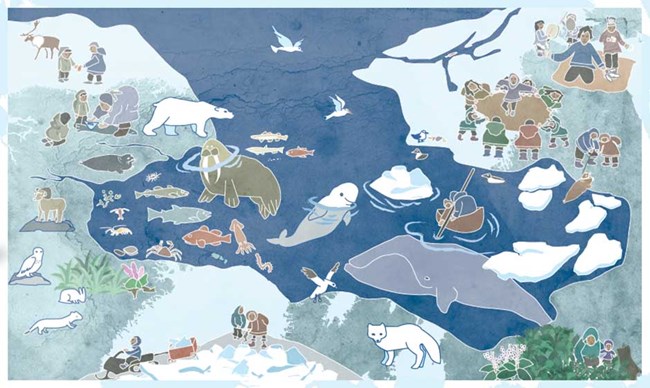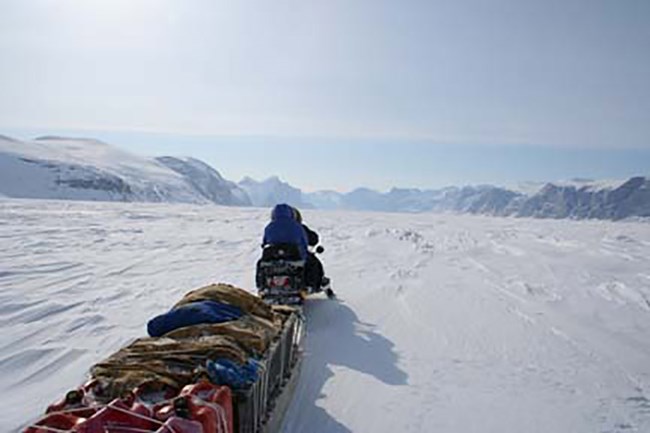
This image was taken from the Inuit Circumpolar Council Alaska publication, Alaska Inuit Food Security Framework: How to Assess the Arctic from the Inuit Perspective.
Today, as in the past, many Alaskans live off the land, relying on fish, wildlife, and other wild resources. Alaska's natural abundance forms the backbone of life and economy for many people in the state, and indigenous people in Alaska have used these subsistence resources for food, shelter, clothing, transportation, handicrafts and trade for thousands of years. Subsistence, and all it entails, is critical to sustaining the physical and spiritual culture of Alaska Native peoples and to making life on the land possible for many of Alaska's rural residents.
Subsistence in more than tradition – it’s the cultural identity of the people who live there. It requires an intimate knowledge of the land, rivers, animals, and weather that can’t be fully captured in words. Knowledge of the land and its bounty has been passed down for generations and continues to live on in the modern descendents.

Photo credit: Guy Norman Omnik
Nunaaqqit Savaqatigivlugich: Working With Communities to Observe the Arctic
“What is a key environmental change in your community that you want people to know about?” “The sea ice and permafrost are melting too fast.“
– Joe Mello Leavitt [Iñupiat], Utqiaġvik (AAOKH 2023).
Numerous lines of evidence indicate how climate change is unfolding in the Arctic. Understanding and responding to these changes, many of which impact coastal Indigenous communities, can be strengthened by the inclusion of community-based observations. Community-based observations provide a local perspective not available through conventional scientific methods alone and can fill existing spatial or temporal knowledge gaps.
The Alaska Arctic Observatory and Knowledge Hub (AAOKH) is a collaboration between university scientists and a network of Iñupiaq observers in northern Alaska coastal communities. AAOKH (pronounced “A-OK”) provides long-term documentation of weather, ocean, sea ice, and landscape conditions and context to wildlife, harvesting, and cultural and community activities by creating space for Indigenous Knowledge holders to share their expertise and observations of environmental change. The primary objectives of AAOKH, determined by the observers, are to sustain Arctic Indigenous observing, support Indigenous scholarship, and apply observations to inform decision-making in response to environmental change. Here, we describe themes in environmental changes observed across the AAOKH network. We also describe our overall efforts to increase knowledge exchange, leveraging our experiences combining scientific measurements with observations to create relevant data products that can directly support community priorities. READ MORE [From the Arctic Report Card, 2023]
Headlines
- The Alaska Arctic Observatory and Knowledge Hub (AAOKH) works with a network of coastal Indigenous observers to document long-term and holistic observations of environmental change and impacts in northern Alaska.
- Recently, Indigenous observers have noted sea ice loss, warmer air and ocean temperatures, changing wind patterns, and increased intensity and frequency of coastal storms that contribute to flooding and erosion.
- Indigenous observers also document local-scale impacts of environmental changes to community and cultural infrastructure, traditional harvests and activities, and travel safety across the land and sea.
- Applying and centering Indigenous perspectives and observations of Arctic change in decision-making can lead to more inclusive, equitable, and community-led responses.

NOAA
After the Ice is a new mini-documentary series sharing stories of Indigenous communities challenged by sea ice loss in Alaska’s Bering Sea. It is a three-part series created through a partnership between the Bering Sea Elders Group and the Study of Environmental Arctic Change.
After the Ice, Part 1: Our Food
After the Ice, Part 2: Our Land
After the Ice, Part 3: Our Story
Ice Edge - The Ikaaġvik Sikukun Story
Ice Edge is a film about a project that combines Indigenous and western ways of knowing to reveal Arctic change. Five years ago, facing momentous changes in coastal sea ice, Iñupiaq residents of the Native Village of Kotzebue along northwest Alaska and researchers from Columbia University and the University of Alaska Fairbanks began a collaborative research project to understand the changes in sea ice cover and implications for the Indigenous way of life.
The project, called Ice Bridges, or Ikaaġvik Sikukun in the Iñupiaq language, melded Indigenous knowledge, aerial monitoring, climate simulations, and ocean and marine mammal science to address questions forged from the beginning through dialogue. The first peer-reviewed studies are emerging, along with a film chronicling the years-long study and the relationships it forged.
About Subsistence in Arctic Parks
-
 Bering Land Bridge National PreserveSubsistence
Bering Land Bridge National PreserveSubsistenceIn the summer months, salmon, sculpin, Arctic char, grayling, and cod are among fish caught by traps or nets.
-
 Cape Krusenstern National MonumentSubsistence
Cape Krusenstern National MonumentSubsistenceWhitefish season gives way to salmon season, just as sure as summer is followed by fall, and people organize their lives accordingly.
-
 Gates of teh Arctic Nat'l Park&PresSubsistence
Gates of teh Arctic Nat'l Park&PresSubsistenceToday, as in the past, many Alaskans live off the land, relying on fish, wildlife and other wild resources.
-
 Kobuk Valley National ParkSubsistence
Kobuk Valley National ParkSubsistenceThe mighty caribou herd and salmon runs provided enough food to see their dogs and them through the long, lean months of winter.
-
 Noatak National PreserveSubsistence
Noatak National PreserveSubsistenceMoose, bear, and wolf are hunted for food and their hides and furs used for clothing.
Last updated: December 14, 2023
